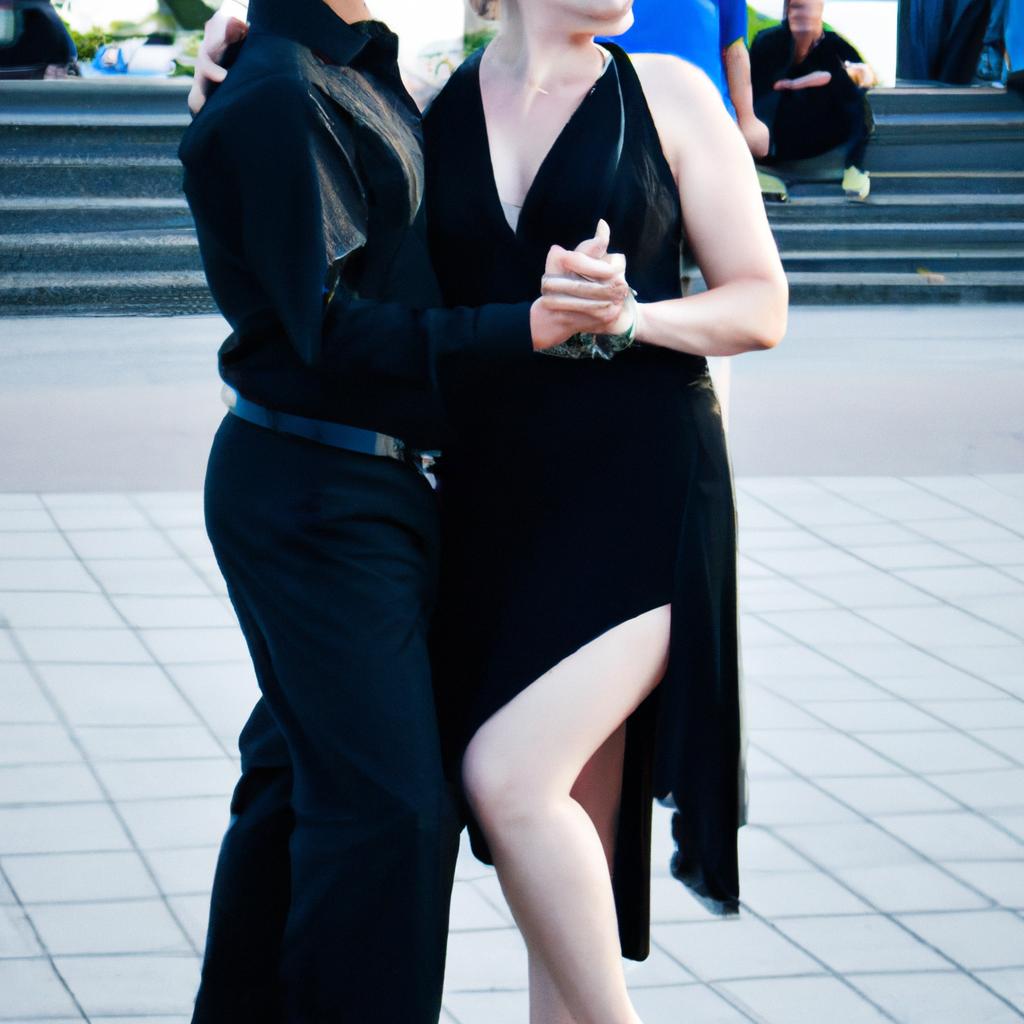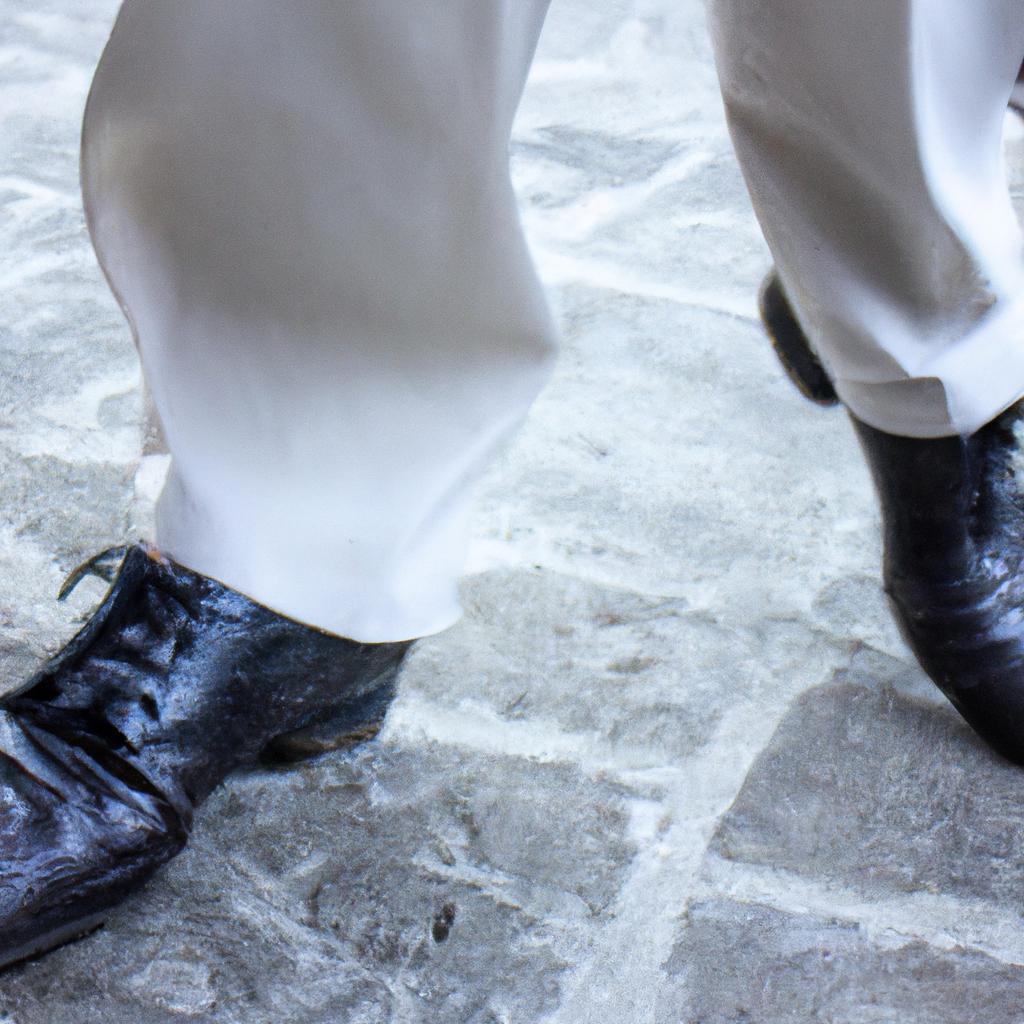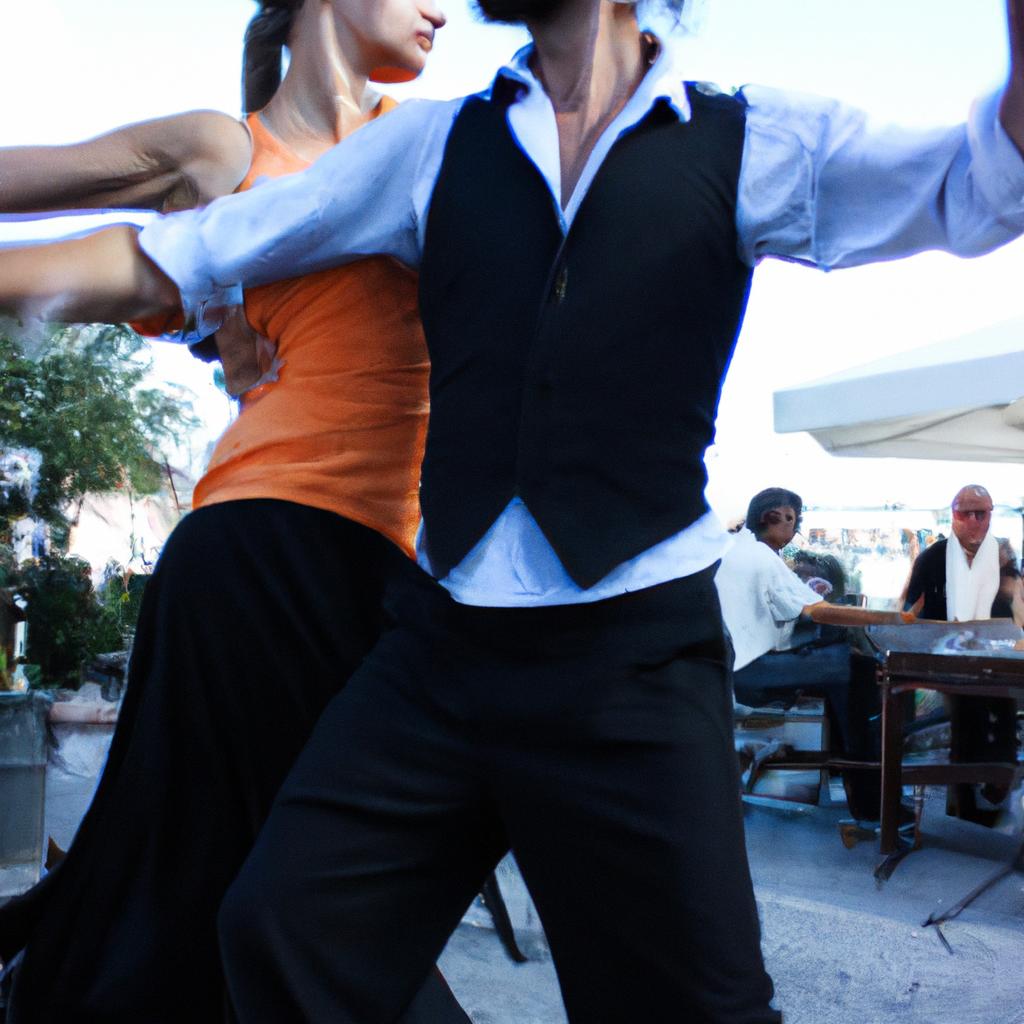The evolution of Argentine Tango is a fascinating phenomenon that encompasses the convergence of music and dance, resulting in an exquisite art form. This intricate dance style originated in the late 19th century in the working-class neighborhoods of Buenos Aires, Argentina. The fusion of African rhythms with European influences created a unique musical genre that captivated both local communities and international audiences alike.
To illustrate this captivating evolution, let us consider the case study of Carlos Gardel, a legendary tango singer who emerged during the Golden Age of Tango in the early 20th century. Gardel’s rise to fame exemplifies how tango transformed from its humble origins into an internationally acclaimed cultural expression. Born in 1890 in Toulouse, France, Gardel migrated to Argentina at a young age and fully immersed himself in the vibrant tango scene of Buenos Aires. His passionate performances showcased not only his exceptional vocal skills but also his ability to embody the emotional intensity and sensuality inherent within each tango piece.
As time progressed, Argentine Tango continued to evolve through various stylistic modifications and adaptations. With influences ranging from jazz to classical music, it found new avenues for growth beyond its traditional roots. The incorporation of bandoneon, a type of accordion-like instrument central to tango The incorporation of bandoneon, a type of accordion-like instrument central to tango, further enhanced the unique sound and character of Argentine Tango. Initially introduced by German immigrants, the bandoneon became an integral part of tango orchestras, contributing to the distinctive melancholic and passionate tones that define this dance style.
In addition to musical innovations, the evolution of Argentine Tango also involved changes in its choreography and performance techniques. As it gained popularity among upper-class circles in Argentina and abroad, tango underwent a transformation from an improvised street dance to a more structured and refined art form. Dancers began incorporating intricate footwork patterns, elegant poses, and fluid movements into their performances, elevating tango to a level of sophistication that continues to captivate audiences worldwide.
Furthermore, Argentine Tango experienced a revival in the late 20th century as dancers sought to preserve its traditional essence while infusing it with contemporary elements. This led to the emergence of various styles within tango, such as Nuevo Tango and Tango Escenario (stage tango), which pushed the boundaries of creativity and experimentation within the dance.
Overall, the evolution of Argentine Tango is a testament to its enduring appeal and adaptability. From its humble beginnings in Buenos Aires’ working-class neighborhoods to its status as a globally recognized cultural phenomenon, this dance form continues to evolve while staying true to its roots. Whether enjoyed on a crowded milonga floor or performed on prestigious stages around the world, Argentine Tango remains an exquisite expression of passion, emotion, and artistic excellence.
Origins of Argentine Tango
One evening in the late 19th century, in the bustling streets of Buenos Aires, two strangers locked eyes across a crowded dance floor. As the passionate music filled the room, their bodies moved with an intensity that seemed to transcend time and space. This encounter marked the birth of what would later become known as Argentine Tango – a unique dance form that blends elements from various cultures and musical traditions.
The origins of Argentine Tango can be traced back to the melting pot of cultural influences present in Argentina during this period. Immigrants from Europe, mainly Italy and Spain, brought their own music and dance styles, which merged with the rhythms of African slaves who were also instrumental in shaping the early tango. The result was a vibrant fusion of European elegance and African sensuality.
To understand the essence of Argentine Tango, it is important to explore its key characteristics:
- Improvisation: Central to tango’s allure is its improvisational nature. Dancers communicate through subtle cues and signals, creating a dialogue between partners without predetermined choreography.
- Emotional expression: Tango has always been associated with intense emotions such as desire, longing, and nostalgia. It serves as a vessel for individuals to express their innermost feelings through movement.
- Connection: In Argentine Tango, connection is everything. Partners engage in close embraces where they maintain constant physical contact throughout the dance. This intimate connection allows for seamless communication between dancers.
- Musicality: The relationship between tango music and dance is symbiotic. Each step taken by the dancers corresponds directly to the rhythmic patterns and melodies played by live orchestras or recorded songs.
| Element | Description |
|---|---|
| Improvisation | Allows for spontaneous creativity within each performance |
| Emotional expression | Enables dancers to convey deep sentiments through body language |
| Connection | Fosters a strong bond between partners through physical contact |
| Musicality | Establishes a harmonious connection between the movements of dancers and the accompanying music |
The origins of Argentine Tango serve as a testament to the power of cultural exchange and adaptation. This dance form emerged from the diverse experiences and influences brought by immigrants and slaves, creating something entirely new in the process.
Early Influences on Argentine Tango
Building upon its origins, the early development of Argentine Tango was shaped by various influences that enriched both its music and dance. One notable example is the influence of African rhythms brought to Argentina by enslaved individuals during the 18th and 19th centuries. These rhythms infused a distinct flavor into the evolving tango form, leading to new syncopated beats and intricate footwork.
The impact of European immigrants also played a significant role in shaping Argentine Tango. As immigrants from Italy, Spain, and other European countries arrived in Argentina seeking new opportunities, they brought their own musical traditions with them. Elements from Italian opera, Spanish flamenco, and Eastern European folk music blended together harmoniously within the context of tango, resulting in a unique fusion of sounds that represented the multicultural fabric of Buenos Aires.
To better understand these early influences on Argentine Tango, consider the following aspects:
- Rhythmic Diversity: The incorporation of African rhythms introduced polyrhythms and syncopation into tango music, creating an infectious energy that resonated with dancers.
- Melodic Expressiveness: The melodic lines in tango compositions were influenced by European classical music traditions such as operatic phrasing and ornamentation techniques.
- Instrumentation: Tango orchestras embraced a wide range of instruments including bandoneons (a type of accordion), violins, pianos, guitars, and double basses – all contributing to the rich tapestry of sound characteristic of this genre.
- Dance Elements: The blending of European ballroom dances like waltz and polka with Afro-Argentine movements gave birth to distinctive tango dance styles characterized by close embrace, passionate leg flicks, quick pivots, and intricate footwork patterns.
Table showcasing key influences on early Argentine Tango:
| Influent | Nationality/Origin | Impact on Argentine Tango |
|---|---|---|
| Africans | Enslaved individuals | Introduction of African rhythms and syncopation |
| Europeans | Italian, Spanish, Eastern European immigrants | Influence on melodic expressiveness and instrumentation |
As Argentine Tango continued to evolve, these early influences laid the foundation for what would later be hailed as the “Golden Age.” During this period, tango reached its peak popularity both in Argentina and abroad. The subsequent section will delve into the cultural and social factors that contributed to this era’s flourishing tango scene.
As we explore the Golden Age of Argentine Tango, it becomes evident how these early influences paved the way for a truly remarkable period in tango’s history.
The Golden Age of Argentine Tango
The early influences on Argentine Tango set the stage for its evolution into a vibrant and dynamic dance form. The fusion of African rhythms, European melodies, and indigenous music from Argentina created a unique blend that captivated both dancers and audiences alike.
One notable example is the inclusion of the bandoneón, an accordion-like instrument with a distinct sound that became synonymous with tango. Its melancholic tones added depth and emotion to the music, enhancing the connection between dancers as they moved in sync with each other’s steps. This harmonious coupling of music and movement paved the way for further innovations in Argentine Tango.
As the popularity of tango grew, so did its influence on society. It became more than just a dance; it became a cultural phenomenon that transcended social boundaries. People from all walks of life came together on milongas (tango gatherings) to experience the magic of tango firsthand.
In exploring the evolution of Argentine Tango, several key factors emerge:
- Passion: Tango embodies intense emotions such as love, desire, longing, and heartbreak. Its expressive nature allows dancers to convey their innermost feelings through fluid movements.
- Improvisation: Unlike many other dance forms, tango thrives on improvisation. Dancers must communicate non-verbally, responding to subtle cues from their partner while maintaining grace and poise.
- Connection: Central to Argentine Tango is the concept of “el abrazo” or embrace. The physical closeness between partners creates a profound connection that goes beyond mere choreography.
- Tradition vs Innovation: Throughout its history, Argentine Tango has struck a delicate balance between honoring tradition and embracing innovation. While respecting its roots, new techniques and styles have continually emerged, keeping tango fresh and relevant.
| Traditional Aspects | Innovative Elements |
|---|---|
| Close embrace | Open embrace |
| Classic orchestras | Electronic tango |
| Traditional steps | Nuevo tango |
| Simple melodies | Complex arrangements |
The Golden Age of Argentine Tango witnessed the emergence of iconic musicians and dancers, solidifying its place in history. As we delve deeper into this vibrant era, we will uncover how new instruments were incorporated, infusing fresh sounds into the ever-evolving world of Argentine Tango.
Transitioning seamlessly from the exploration of early influences, let us now turn our attention to the incorporation of new instruments in Argentine Tango.
Incorporation of New Instruments in Argentine Tango
The Golden Age of Argentine Tango witnessed a remarkable convergence of music and dance, establishing the genre as an emblematic cultural expression. Building upon its roots in the late 19th century brothels and working-class neighborhoods of Buenos Aires, tango underwent a transformative period during the first half of the 20th century. This section explores how key musicians and dancers contributed to the flourishing era that came to be known as the Golden Age.
One notable example is Carlos Gardel, who emerged as one of the most influential figures in tango history. Born in Toulouse, France, Gardel moved to Argentina at a young age and quickly became an icon through his distinctive voice and charismatic stage presence. His recordings from this era continue to captivate audiences with their emotional depth and poignant storytelling.
During the Golden Age, several characteristics defined Argentine Tango:
- Intense emotions: The melodies and lyrics conveyed profound sentiments such as love, longing, jealousy, and despair.
- Intricate rhythms: Tango evolved into a complex genre with syncopated beats that challenged both musicians and dancers.
- Dynamic improvisation: Musicians often engaged in spontaneous dialogue within ensembles, creating moments of musical interplay.
- Elegant movements: Dancers perfected intricate footwork patterns while maintaining an intimate connection with their partners.
To illustrate these aspects further, consider Table 1 below which showcases some iconic tangos from this period along with their characteristic themes:
| Song Title | Theme |
|---|---|
| “La Cumparsita” | Yearning for lost love |
| “Mi Noche Triste” | Despair after heartbreak |
| “Caminito” | Longing for familiar places |
| “Volver” | Bittersweet return |
This table serves as a reminder of the evocative power embedded within each tango composition. As listeners were transported by the melodies, dancers embraced these themes through their movements on the dance floor.
The Golden Age of Argentine Tango not only solidified its position as a cultural phenomenon but also paved the way for further innovations. As the genre continued to evolve, it underwent significant transformations that incorporated new influences and expanded its artistic possibilities. The following section will explore how this modernization unfolded, shaping tango into what it has become today.
Transitioning seamlessly into the subsequent section about “Modernization of Argentine Tango,” we delve deeper into the transformative journey undertaken by this captivating art form.
Modernization of Argentine Tango
The incorporation of new instruments in Argentine Tango was a crucial element in the evolution and development of this unique dance form. This section explores how the introduction of different musical instruments added depth and complexity to tango, further enhancing its emotional appeal.
One fascinating example is the bandoneón, an accordion-like instrument that became an integral part of Argentine Tango during the late 19th century. Its melancholic sound and expressive capabilities perfectly complemented the passionate movements of tango dancers. The bandoneón’s ability to sustain notes created a haunting atmosphere, evoking deep emotions within both performers and audiences alike.
This expansion in instrumentation marked a significant shift in the evolution of Argentine Tango. It diversified the sonic palette and allowed for greater expressiveness through music. Alongside the traditional guitar and violin ensemble, other instruments like piano, double bass, flute, clarinet, and even electric guitars began finding their place within tango orchestras. This fusion resulted in a rich tapestry of sounds that intensified the sensual allure of this captivating dance style.
- The addition of new instruments brought about fresh tonal possibilities.
- The expanded instrumental arrangements heightened dramatic tension throughout performances.
- Innovative harmonies emerged as musicians experimented with diverse combinations.
- The inclusion of unexpected timbres enhanced audience engagement by eliciting surprise and intrigue.
Moreover, let us examine this table showcasing some key examples from tango’s evolving instrumentation:
| Instrument | Role/Contribution |
|---|---|
| Bandoneón | Expressive melodic lines |
| Piano | Harmonic foundation |
| Double Bass | Rhythmic pulse |
| Electric Guitar | Modern twist on traditional sound |
As we can see from our discussion above, incorporating new instruments into Argentine Tango opened up endless artistic possibilities while still preserving its essence. By expanding beyond traditional boundaries, musicians were able to push the boundaries of creativity, resulting in a captivating and emotionally charged dance experience.
This exploration into the incorporation of new instruments sets the stage for our subsequent section on the international spread and popularity of Argentine Tango. It demonstrates how these musical enhancements played a pivotal role not only within Argentina but also across borders, propelling tango onto an international platform.
International Spread and Popularity of Argentine Tango
The Modernization of Argentine Tango showcased the evolution and adaptation of this traditional dance form to suit contemporary tastes. However, its transformation did not end there; instead, it propelled Argentine Tango into a global phenomenon. As dancers and musicians pushed boundaries, incorporating new elements while preserving the essence of the dance, tango found its way onto international stages and captured the hearts of people worldwide.
One compelling example that exemplifies how Argentine Tango has gained widespread recognition is the case of Maria and Carlos (pseudonyms), two passionate tango enthusiasts from Buenos Aires who embarked on a journey around the world to share their love for this art form. Through workshops, performances, and social events, they introduced thousands of individuals from diverse cultures to the beauty and intricacies of Argentine Tango. Their dedication not only promoted cultural exchange but also fostered an appreciation for the music and dance beyond Argentina’s borders.
As Argentine Tango began transcending national boundaries, four key factors contributed to its growing popularity:
- Rich Cultural Heritage: The history and traditions associated with Argentine Tango resonated with many as they sought to connect with a profound sense of nostalgia and authenticity.
- Expressive Music: The emotionally charged melodies performed by talented orchestras struck a chord in listeners’ hearts, evoking feelings of passion, longing, joy, and melancholy.
- Intimate Connection: The close embrace between dancers allowed for an intimate connection that transcended language barriers, creating a universal understanding among participants.
- Elegance in Movement: The intricate footwork combined with graceful body movements mesmerized spectators, capturing their attention through the sheer elegance exhibited by dancers.
To further illustrate these points:
| Factor | Emotional Response |
|---|---|
| Rich Cultural Heritage | Nostalgia |
| Expressive Music | Deep Emotional Connection |
| Intimate Connection | Universal Understanding |
| Elegance in Movement | Mesmerizing Gracefulness |
In conclusion, the international spread and popularity of Argentine Tango can be attributed to its ability to evoke powerful emotions through a combination of rich cultural heritage, expressive music, intimate connection between dancers, and elegant movements. As individuals like Maria and Carlos continue to introduce tango to new audiences worldwide, this beautiful dance form will undoubtedly continue evolving while remaining grounded in its traditional roots. It is an art form that unites people across borders and inspires a deep appreciation for both music and dance.




